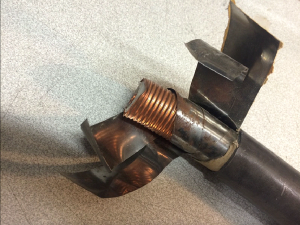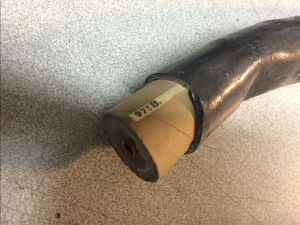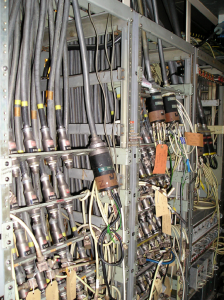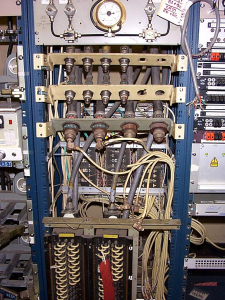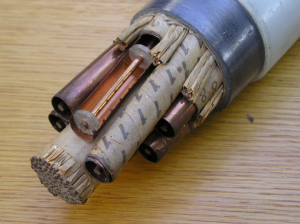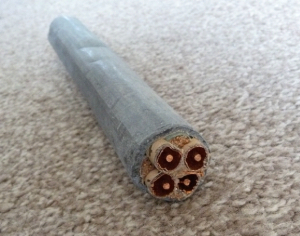Simon Vaughan (Alexandra Palace Television Society)(www.apts.org.uk)
Simon asked Tech Ops if they could help in identifying a length of cable – this was rescued during the decommissioning of TVC from SCAR Stage 6 and was found in a locker: the cable has been donated to the APTS Archive. It seems that a section of it has been used to demonstrate the construction of the cable – perhaps within an engineering capacity
(Click on the pictures below to see larger version:
use your Browser’s BACK button to return to this page)
A BBC book was also found with the cable – and stamped “AP Library”!
Mike Jordan
I think it might be an aerial feeder cable since the copper outer bit is corrugated and would have upset video but would be more suitable for rigging up a mast where tighter bends were required.
It is similar to BT (GPO) coaxial cable as used between premises. You don’t say what diameter it is but it looks a bit like a 1” diameter cable.
Several of these were encased in a larger overall sleeve with copper telephone pairs to make a circular format. They were separated out near the end and terminated as several separate cables on Burndept connectors
This photo is the terminations of such a cable in the BH Switching Centre shortly before it was closed and demolished.
(Click on the picture below to see larger version:
use your Browser’s BACK button to return to this page)
The ones on the left were 1” tubes between BH and Western House (BHWH) and also to Museum Exchange (BHMU) and smaller ones to Museum (MUBC – broadcasting centre) AP (via Swains Lane – the BCAP cable) and alongside is a more modern cable with 4 0.174” cores.
The ones to the right were 3/8” tubes to places like TC (AC-TOW – Acorn exchange (Acton)-Tower) and YZAR-YTVC (BH and TC) and the LOCO (LOndon CO-axial) network around London for OB inserts.
I took these myself and noticed my Dymo and paper labels from about 1969 were still in situ!
The photo below is of the cables arriving/leaving Swains Lane on the way between BH and AP.
(Click on the picture below to see larger version:
use your Browser’s BACK button to return to this page)
The small ones at the top are AP 1 – 4 and big ones on the right in the middle are still labelled AP 5 – 6. The U links below are the “Interstice pairs” of copper telephone pairs used to make the overall cable circular.
The meter at the top was a pressure tester in the SHF links waveguides (to keep water out!).
The picture below shows the construction of a typical GPO cable complete.
(Click on the picture below to see larger version:
use your Browser’s BACK button to return to this page)
Dave Buckley
The photo below shows an off-cut of a four tube co-ax, which was part of a cable run from the
roundabout at the end of Shepherds Bush Green to Woodstock Grove about 1981.
(Click on the picture below to see larger version:
use your Browser’s BACK button to return to this page)
The cable replaced office viewing circuits which used balanced pair telephone lines and ran from TVC, Threshold House, Union House and (possibly) TV Theatre, through WG PO frame room, finishing in the PABX at Ken House.
The new co-ax cable terminated in the WG PO frame room and then routed to the TV Training Studio equipment bays, before being sent on to the PABX in KH.
The reason I say that the cable started at the roundabout is that, for quite a few months, there was a very tatty and dirty yellow PO van working around the area with a large representation of a Co-Ax tube with the words ‘Co-Ax unit’ on the back door. I always had a laugh when I saw this van as the handle on the rear doors had broken off and they were held shut with a hasp and staple and a padlock!
So far as I know, the unit was installing extra circuits between BH and TVC due to the closure of the Switching Centre, so that TVC could remotely select sources. I think there were eight circuits BH – TVC, and the opportunity was taken to add four from WG – TVC so that there were 12 circuits across the Green towards TV Theatre etc. I also heard that the Co-Ax unit had found some of the redundant TVC- Riverside circuits that ran along outside TV Theatre etc and they may have used these to get into TVC.
While all the installation was going on, I came in to WG one day to find the tatty van parked outside the gates, and the BT crew standing around looking rather puzzled. Commenting on their van and the fact that I knew what they were doing, I asked what was the problem. They had been ‘poling’ the conduit from the pavement on one side of the road to the cable ‘ladder’ up the side of the building, but could only get so far from each end.
I went to my office and removed a photo from the wall which had been taken by my colleague, Dick Hammett, when he was testing a new camera a few years previously, and took it to show the BT crew.
The photo showed road works (by Hammersmith Council) immediately outside the WG gates about 1976/7 when a storm drain was being installed. Across the centre of the photo was the TVC – WG two tube co-ax cable plus a couple of earthenware ducts, hanging in mid-air on some horizontal wooden supports. It was now obvious to the BT crew as to why they couldn’t find the cable duct! The road had to be dug up to put in a new duct to take the cable, and I heard that BT were thinking of suing the Council for the damage caused, although whether this happened, I don’t know.


